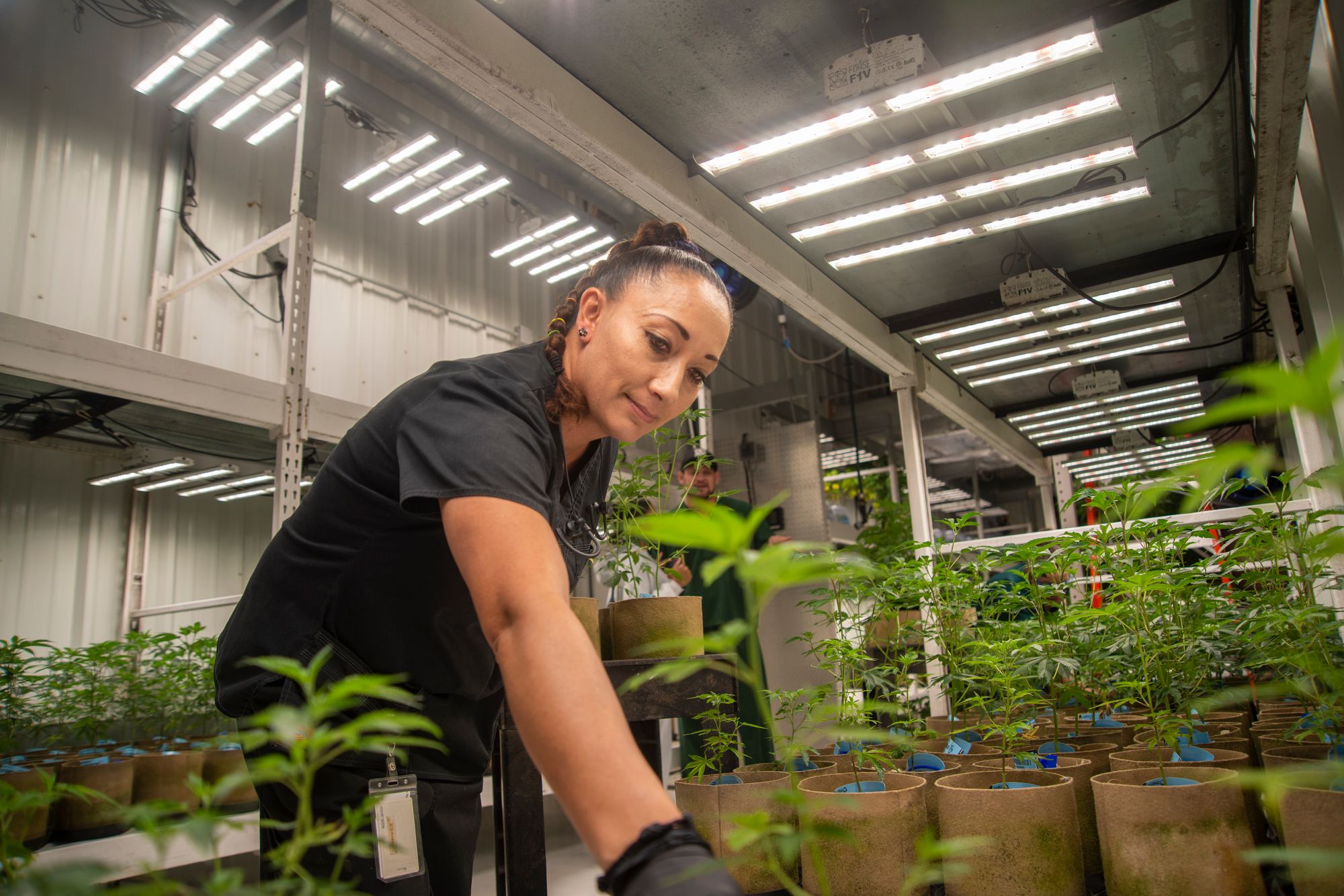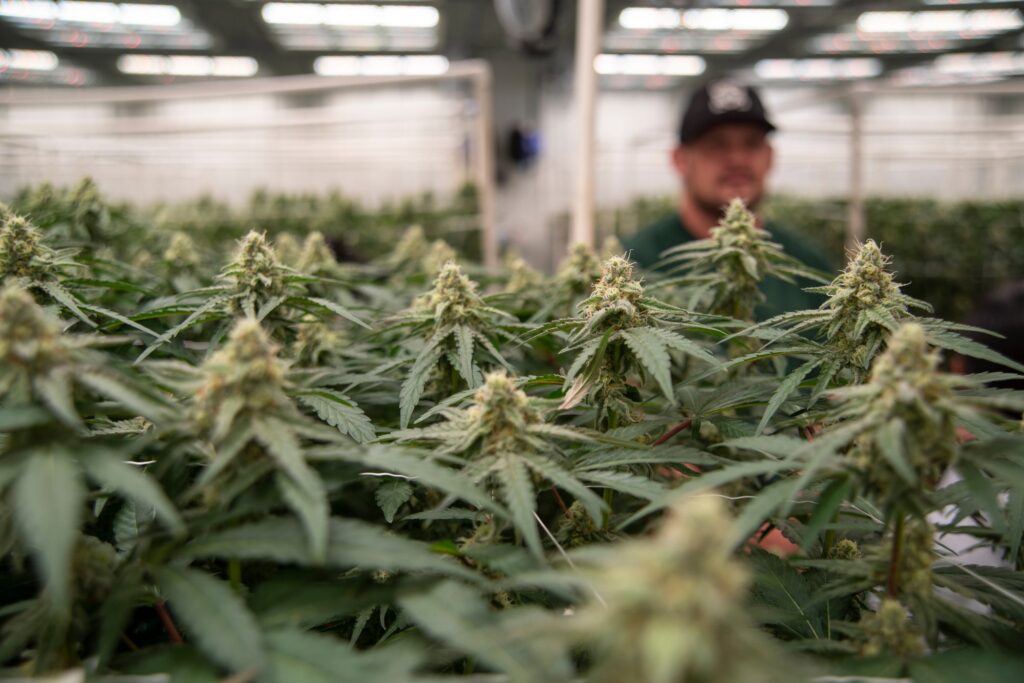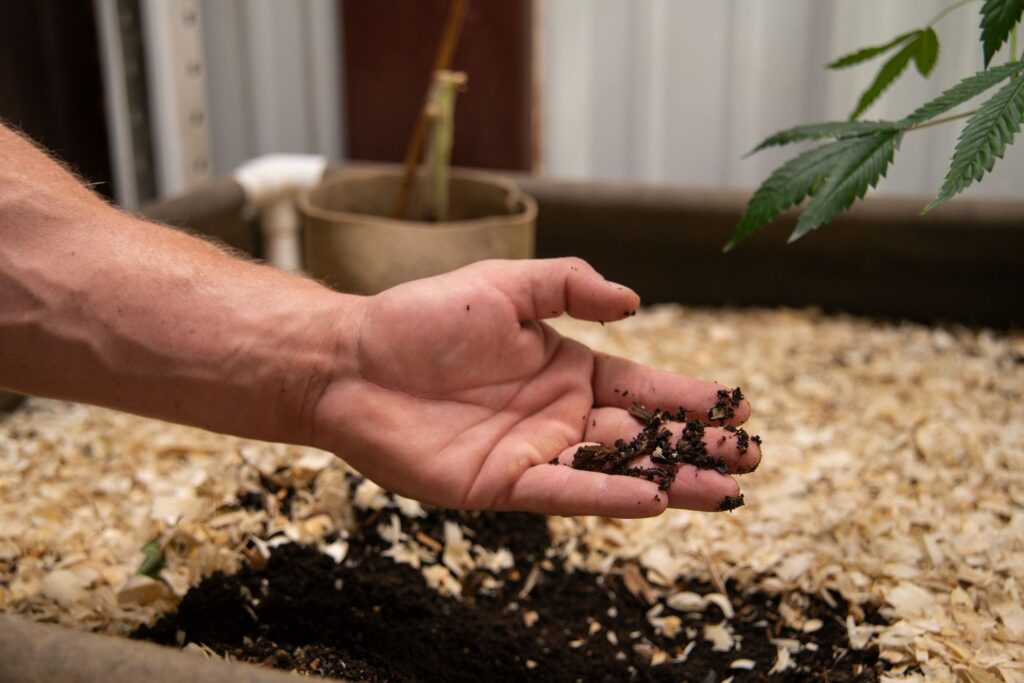Organic cannabis cultivators seeking more flexibility from state regulators

A Pahrump-based cannabis cultivator wants to grow marijuana organically, making its own compost and mulch using non-psychoactive cannabis waste in the process.
The problem? The regulatory structure governing Nevada’s marijuana industry doesn’t yet recognize these natural growing methods, leading to Green Life Productions (GLP) receiving hefty inspection bills totaling $40,000 from the Cannabis Compliance Board.
For the last seven years, GLP has used natural farming techniques to keep its harvests pesticide-and-radiation-free and its farm sustainable with limited water use and waste. But a routine inspection by state regulators led to a year of farming corrections despite the cultivator’s positive reputation for passing tests that screen for harmful bacteria and contaminants.
“The CCB basically said, these are things that we need more information on,” said Scot Rutledge, the lobbyist representing GLP, in an interview. “Or they told [GLP] ‘you can’t do this’ because there’s nothing in the [regulations] that allow for it. Or in fact, it was contrary to what the [regulations] allowed for.”
It all started in 2021 when inspectors made their annual visit to the cannabis-growing facility. The state inspectors took issue with several of what GLP called natural and sustainable farming practices, such as the in-house production of compost and mulch created from recycled, non-psychoactive plant waste.
In Nevada, cannabis growers have to legally account for all of their cannabis waste by weighing it and destroying it. At GLP, growers allowed fallen and clipped leaves to become mulch, a protective cover for soil, or use the waste to create a fertilizer, or compost — techniques that violate the regulations established by the compliance board.
The state Cannabis Compliance Board was created in 2019, several years after adult-use recreational cannabis was legalized in Nevada. Prior to its existence, cannabis operators were regulated by the Nevada Department of Taxation and the Department of Health and Human Services.
Now, Green Life Productions is petitioning the compliance board to add 15 new definitions to its regulatory structure, allowing for growing methods that incorporate mulching and composting. The board approved a policy workshop for the petitioners — a kind of first step toward making that change — which will take place at the next board meeting in November.
“There are some things that are specifically prohibited in the regulations that we're reviewing, to allow for,” said Kara Cronkhite, the leader of the inspection and audit division at the Cannabis Compliance Board. “However … there's a lot of steps that need to be executed in order to make sure that [cultivators] are doing these processes in a manner that's safe — that's not going to harm the end consumer or the workers.”
She said that each cannabis-growing facility is inspected at least once a year to ensure the facility is clean and safe. She said additional inspections are carried out if complaints arise, the facility repeatedly fails tests looking for contaminants or for “anything that might trigger [a board agent] to have some concern with a facility.”
Board agents, who are agriculture and environmental specialists, use a checklist during inspections to see if cultivators are within compliance, and anything outside of that is recorded in a “statement of deficiency.” If a facility is issued a statement of deficiency, it’s expected to respond with a corrective action plan within 10 days.
Besides adding definitions to the law, the petition from GLP asks the compliance board to consider organic methodologies that align with sustainable and natural farming practices, such as recycling water leaves — the large, fan-like cannabis leaf that absorbs UV rays and is often used as a marijuana insignia.

Rutledge, a former environmental lobbyist, presented the GLP’s petition to the compliance board during the September board meeting, and argued that the farming techniques used should be recognized in the law, because they align with the growing standards used by federal agencies..
“They've halted their process,” Rutledge said. “Until we get these new definitions updated … and included in the regulations.”
The petition comes a year after the compliance board issued GLP a cease-and-desist order over their farming system, requiring them to adopt new processes to maintain a natural farming system, as the inspection and corrective process continues.
“The goal is always to get our licensees into compliance no matter what,” Tyler Klimas, executive director of the CCB, said in an interview. “And the petition that they filed last month ... is a good move towards solidifying some of the processes that are out there, and putting them into the regulations.”
Steven Cantwell is a mixed martial artist and medical cannabis patient who co-owns GLP with his wife, Kouanin Cantwell. In 2021, he said the inspector’s initial surprise came over their use of atypical cannabis cultivation techniques — no-till soil beds covered with leafy foliage and thinly shredded wood, and the use of fabric bottomless pots for cannabis plants that grow down into soil without digging.
“I think the CCB – coming out of this – will now be equipped to assist other odd growers,” Rutledge said in an interview inside of a GLP flowering room in full bloom. “If it’s not codified into the [regulations], then the next person coming in ... can come in and say – I don’t get this. So, this is a way of ensuring that what they’re doing lives in those [regulations].”
GLP has since worked with the compliance board and provided information about its growing practices while pausing specific sustainable methods that have not been defined in state cannabis law or accepted by the board as a regulation.
After the inspection, Cantwell began outsourcing compost from California and discontinued his in-house thermophilic composting — a process that involved Cantwell creating a fertilizer through heat produced by the rapid reproduction of microorganisms, using decomposed cannabis waste and wood shreds.
“It's cool to have an excuse to use a different kind of compost,” he said, “because we're kind of adopting microbes that typically don't grow here…But at the end of the day, I’d rather use my own compost.”
Living soil
Rutledge said he and his client went back and forth with the compliance board to explain their approach to managing pests and enriching soil, while dealing with a corrections plan and updating GLP’s operating procedures.
Cantwell said for several years, he’s taken organic farming courses from soil experts and that GLP is grown from living organic soil — a term that he said refers to soil that is filled with natural organisms, mites, worms, rollie pollies, fungi and many kinds of beneficial microbiology or insects that break down organic matter and “make it available to the plant through various processes.”

“We were one of the first [cultivators] to try to utilize natural systems that you see in nature, in an indoor controlled environment,” Cantwell said.
The base of cannabis plants at GLP are surrounded by companion plants, or plants that help each other grow, and cover crops, plants that prevent soil erosion, nitrogen leaching and weed and pest growth, that make up a living mulch. He said this gardening strategy uses natural processes to keep the soil protected from air debris, pests and harmful new microbes that could be tracked into the facility.
Living mulch at GLP includes short plants, such as the bright green, umbrella-like dichondra that shields the soil, mint that deters pests, potatoes that are nutrient-rich, and sometimes flowers that capture pests. Cantwell said this process can be maintained naturally through growth cycles, without replanting, and keeps the soil nutrients balanced, or at homeostasis.
The CCB allowed him to continue his living soil and mulch systems, but he can no longer use water leaves or other cannabis plant material that would be trimmed or fall off into the soil as part of the mulch system.
“We used to take our water leaves, and put them right on the soil,” Cantwell said. “They never left where they were placed and within a week they were eaten up — two weeks tops.”
Under the compliance board’s regulations, cultivators have to weigh the fallen or trimmed leaves and then trash them. But Rutledge and Cantwell argued that the practice could increase the risk of diversion — a term that refers to the transferring a controlled substance from a lawful distribution to “the black market” because it creates more “bags out the door.”
They said their current method replicates natural processes and reduces waste, which reduces the chances of inadvertently smuggling cannabis outside of the facility.
“A lot of these things are as basic and as natural as it gets,” Cantwell said. “A lot more natural than you'd even see [at] some outdoor grows … minus my lights.”
He said the loss of those plants’ nutrients meant he had to buy them from elsewhere and add them to the soil.
“There’s some things that I don’t do [anymore], that I would love to do,” he said.
They are asking the compliance board for permission to continue recycling cannabis waste for mulching and composting, without weighing it, as long as they alert the board about it through the state’s seed-to-sale tracking system.
Another mechanism Cantwell is prevented from carrying out is brewing a “compost tea” that he would use for watering. Now, he uses water to hydrate the plants, a change he said slows down their growth process.
“It gives me a jumpstart when I could brew a tea, inoculate my [flower] beds with active microbial life, versus dormant,” Cantwell said in an early vegetative room with sprouted clones. “The soil wakes up slower … At the end of my cycle, my soil slows down, just like it does in nature. And then it picks back up. So without using these teas, I'm not able to ramp up my soil as fast as I used to.”
The request for changes comes years after implementing the farming practice and weeks after cultivators asked the board and the state Department of Taxation to revisit cannabis wholesale taxes because of rapid inflation and falling cannabis prices, causing profit margins to “disappear.”
Klimas said there is a high risk for diversion among cultivators and that it is important that every plant, down to its waste, is accounted for.
“[Diversion] is fairly common, and continues to be too common for our comfort level,” he said. “I mean, especially now that we're starting to see the industry, economically, come a little bit back down to earth.”
The gold standard
Klimas said one of the goals of the compliance board is to make Nevada’s cannabis industry the “gold standard” in the nation, and that a properly regulated industry will ensure this goal.
“When you talk about public trust and confidence, in any regulated industry, that's everything,” he said. “And you know, just two, three years ago … we had no public trust and confidence in cannabis here in Nevada... Now the issues that we're talking about are time and effort [billing]… we’re talking about issues like fines and fees, which to me shows progress.”
Klimas said the compliance board is focused on building a strict regulatory body with public safety at the forefront.
Besides untagged plants — the most common issue found among cultivators — board agents have discovered other health issues such as toxic mold, rusty leaking pipes and disease-carrying insects inside a small number of cannabis-growing facilities.
While the compliance board remains focused on public health, Cantwell and Rutledge have raised another issue — the “time and effort billing and work ongoing” invoice they received from state regulators came with a huge price tag, saying it was too vague because it stated “time and effort billing and work ongoing” with no further details.
The compliance board billed GLP $111 per hour for “time and effort” related to inspections that lead to a corrective action plan, a publicized example of a practice that brings in about $2.5 million a year out of a yearly agency budget of $10.5 million.
When asked about it, Klimas said the bill format is standard practice and that it stems from the Nevada Gaming Commission’s model of regulating the state’s gaming industry, which is what the board is hoping to recreate in the cannabis industry.
“In our own backyard … we've got one of the greatest examples of a gold standard regulatory body, which is the Nevada Gaming Control Board and the Nevada Gaming Commission,” Klimas said. “So that's kind of how they designed this agency.”
Rutledge said he expected the bills that amounted to $40,000 to include pages of research and data, but the company received a single page that showed the board spent 63 hours reviewing GLP’s methodology.
“It took them that long to review all of the documentation we sent them,” Rutledge said. “It's just frustrating because at the end of the day, even if all of those hours are officially accounted for, our concern is and always has been, if the end result of their methodology achieves a 99 percent pass rate, when their product is tested at various labs, what were the issues?”
Klimas said a pass rate does not mean a facility is in compliance with the law and that safety includes workplace environments.
Cantwell said he understands the “mess” the compliance board is taking on and that he “respects the process.” He said bad actors exist and they might abuse things like remediation, or the process of using radiation to kill bacteria and mold on cannabis that fails microbe testing, or use harmful substances to grow cannabis that go untested.

Cantwell said GLP has earned a positive reputation in the cannabis industry for being model growers and now they feel like they’ve been “sat in detention.” At the last board meeting, public commenters asked the board to allow GLP to continue its organic growth processes.
“Usable cannabis describes every aspect of this plant right now — in statute,” Rutledge said. “What we want to do is say — if parts of the usable plant are not going to be used for the purpose of selling or extraction — then let us put it back into the soil for mulching and composting.”
Cantwell said he hopes that there is flexibility or room for GLP to work with the compliance board to determine, together, the gold standard for cannabis grown in Nevada.
“What they’re considering is the gold standard for cannabis — I don’t know,” he said. “I feel like they can definitely do more to work with us considering this is so new. We are all learning.”
